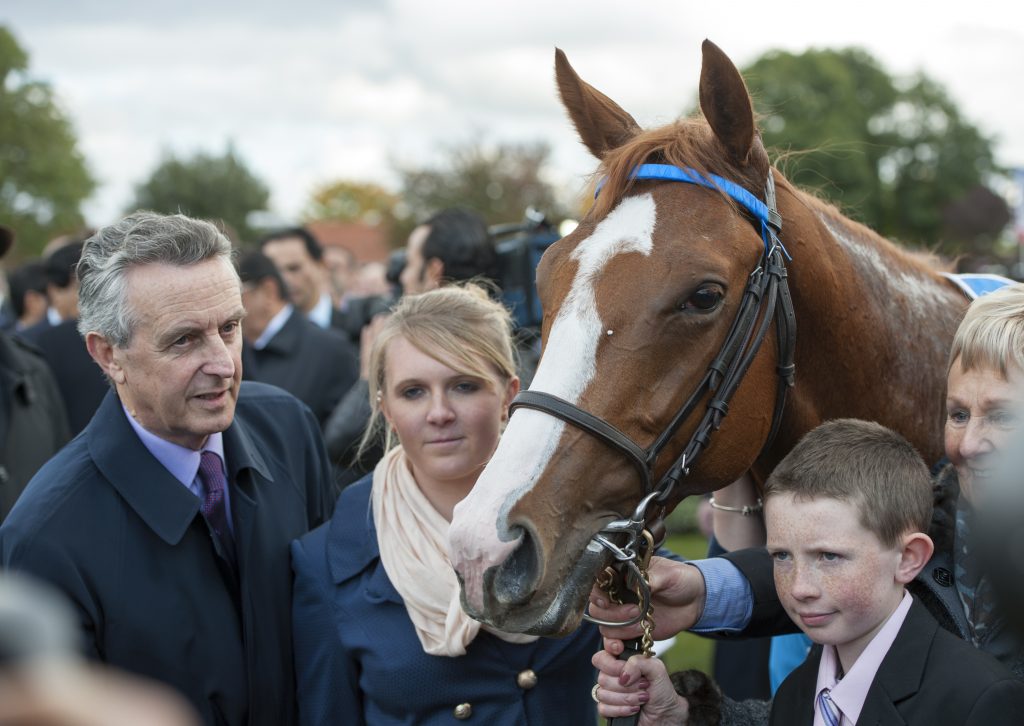Considering that the average winning distance for the progeny of the Derby-winning Galileo stands as high as 11.1 furlongs, this extraordinary stallion might seem a rather unlikely candidate to exert an extremely strong influence on the 2,000 Guineas. That, though, is exactly what this brilliant stallion has been doing since his son New Approach failed by only a nose to lead throughout in the 2008 edition.
Subsequent years have seen Galileo represented by three winners of the first colts’ classic, in the impressive forms of Frankel, Gleneagles and Churchill. Galileo’s daughters have also reinforced his impact, producing an admirable tally of four winners in Night Of Thunder, Galileo Gold, Saxon Warrior and Magna Grecia. And New Approach has been busily making amends for his very narrow defeat, siring the 2013 winner Dawn Approach, who in turn sired Poetic Flare, the short-head conqueror of Master Of The Seas in the most recent edition. So, one way or another, Galileo figures in the pedigrees of nine of the last 11 winners of this stallion-making classic.
For good measure, it was Galileo’s remarkable daughter Cabaret who was responsible for St Mark’s Basilica, winner of the 2021 Poule d’Essai des Poulains, in which Poetic Flare disappointed. Perhaps we shouldn’t be too surprised at all this success at a mile, given that Galileo is himself a son of Sadler’s Wells, an Irish 2,000 Guineas winner who also sired three winners of the 2,000 Guineas, compared to just two of the Derby.
Needless to say, Galileo isn’t the only recurring theme among some of these 2,000 Guineas winners, with Jim Bolger being the breeder and trainer of both Dawn Approach and Poetic Flare (as well as the trainer of New Approach). Bolger, of course, also bred and trained Teofilo, the unbeaten champion juvenile from Galileo’s second crop. Had soundness issues not intervened, Teofilo would also have had a strong chance of winning the 2,000 Guineas, as the first three in the 2007 classic – Cockney Rebel, Vital Equine and Dutch Art – had respectively been rated 8lb, 7lb and 2lb inferior to Teofilo as two-year-olds.
“Galileo figures in the pedigrees of nine of the last 11 winners of the stallion-making classic, the 2,000 Guineas”
Bolger must be proud that Poetic Flare comes from the same family as Teofilo, with the Majestic Light mare Saviour ranking as the second dam of Teofilo and third dam of Poetic Flare. Saviour won at up to 11 furlongs for Bolger, but without showing nearly as much talent as three of her siblings. Her brother War took the Grade 1 Blue Grass Stakes on the demotion of future Kentucky Derby winner Alysheba. Two of Saviour’s half-brothers, Judge Angelucci and Peace, also became Grade 1 winners over nine furlongs, with Judge Angelucci being good enough to finish third in the Breeders’ Cup Classic.
Dawn Approach, like Teofilo before him, took up stallion duties at Kildangan Stud. But, whereas Teofilo is still a resident, having sired a string of Group or Grade 1 winners, including six in 2020, Dawn Approach fared less well, despite appearing to have most of the ingredients required for success.
A colt needs to be very tough, talented and precocious to achieve what Dawn Approach did as a two-year-old, when his unbeaten sequence of six wins featured the Coventry Stakes, National Stakes and the Dewhurst. And he needs to be highly talented to add the 2,000 Guineas and St James’s Palace Stakes at three. There was also quite a strong physical resemblance between Dawn Approach and his sire New Approach, whose CV as a stallion includes not only the 2,000 Guineas but the Derby and the Oaks, thanks to Masar and Talent.
Dawn Approach started his career in 2014 at a fee of €35,000, but by the time his first progeny were three-years-old he was available for €20,000, with his fee then slumping to €15,000 in 2019 and €10,000 in 2020. Even the latest reduction wasn’t enough to stop his book falling to only 32 mares in 2020, but that slump doesn’t necessarily signal the end of his career, as no fewer than 21 of the 32 are listed as belonging to a certain J.S. Bolger. One, Bring Back Matron, is a sister to Maria Lee, the dam of Poetic Flare. Dawn Approach has now returned home to Redmondstown Stud, where he is standing alongside the talented Vocalised and Bolger’s homebred Dewhurst Stakes winner Parish Hall.
Parish Hall acts as a reminder that Bolger isn’t averse to using close inbreeding in his quest to hit that elusive Group 1 target. With Teofilo as his sire and a Montjeu mare as his dam, Parish Hall is inbred 3 x 3 to Sadler’s Wells, whereas Mac Swiney, winner of last year’s Vertem Futurity Trophy, is by New Approach out of a Teofilo mare and is therefore inbred 2 x 3 to Galileo.
A look at the 21 mares which Bolger sent to Dawn Approach in 2020 suggests that Bolger is far from finished with the experiment of inbreeding to Galileo. Three of the mares are by Galileo himself, so would produce 3 x 2 to Galileo; another three are out of Galileo mares, and therefore produce 3 x 3; and four others are out of Teofilo mares, which produce 3 x 3. Thunder Kiss, a Night Of Thunder filly who was recently a good second in the Blue Wind Stakes, is another inbred 3 x 3 to Galileo, her dam being yet another Teofilo mare.

Jim Bolger with Dawn Approach, the sire of his recent 2,000 Guineas winner Poetic Flare
Celtic Times, a recent juvenile winner for Bolger, is by Dawn Approach out of a Teofilo mare, so is also inbred 3 x 3 to Galileo. Although Dawn Approach has yet to sire anything very much out of the ordinary with Galileo inbreeding, it may pay to keep an eye out for some of Bolger’s other Dawn Approach two-year- olds with a second line of Galileo, such as Litteratus (3 x 2), Flash Of Dawn (3 x 2), Level Pitch (3 x 2), Breacadh (3 x 3) and RunAtDawn(3×3).
Although I have so far concentrated on the Galileo aspect of Poetic Flare’s pedigree, Galileo should at least share some of the credit for the colt’s classic success with Poetic Flare’s broodmare sire Rock Of Gibraltar, who also sired the dam of Kameko, winner of the 2020 2,000 Guineas.
It seems a long time ago that Rock Of Gibraltar joined the Coolmore stallion team for 2003. His fee for his first season wasn’t published, but it was certainly substantial (it stood at €65,000 in his second season and €55,000 in his third). Now 22, he is available for only €5,000, having attracted only 21 mares in 2019 and 25 in 2020.
This suggests that, despite siring winners of the calibre of Society Rock, Mount Nelson, Prince Gibraltar, Varenar and Samitar, Rock Of Gibraltar’s stallion career has fallen short of the very high standards he’d set on the racecourse. Beaten only three times in 13 starts, Rock Of Gibraltar became the first horse to win seven Group 1 races in succession since the European pattern system was introduced in 1971. As a winner of the Grand Criterium, Dewhurst Stakes, 2,000 Guineas, Irish 2,000 Guineas, St James’s Palace Stakes, Sussex Stakes and Prix du Moulin, Rock Of Gibraltar thoroughly earned his status as champion miler.
“Galileo should at least share some of the credit for the colt’s classic success with Poetic Flare’s broodmare sire Rock Of Gibraltar”
Breeders operating on a restricted budget need to pay attention to any outstanding racehorse whose stallion career proved anti-climactic, on the basis that their eldest daughters sometimes represent very good value. The explanation is that high-priced stallions usually benefit from the best mares, many of them from female lines which have flourished for generations. Kameko’s dam, Sweeter Still, was a member of Rock Of Gibraltar’s €65,000 crop. Despite developing into a Grade 3 winner in the US, Sweeter Still sold for as little as $35,000 in 2016 and for a mere $1,500 two years later.
Poetic Flare’s dam Maria Lee was conceived at a fee of €45,000 in 2006. However, she was foaled as late as May 31 and didn’t make it to the track until the October of her three-year-old season, when she finished 13th of 18 on what proved to be her only appearance. She too was sold in 2018, after producing Poetic Flare a few months earlier, her price being €65,000. She was carrying a brother to Poetic Flare named Frazil, who sold cheaply as a foal. The mare also has a yearling filly by U S Navy Flag.
The chances are that Rock Of Gibraltar will continue to do well as a broodmare sire, a role which has already yielded five Group/Graded winners in 2021, plus a pair of Listed winners. The best previous winners out of Rock Of Gibraltar mares include two Group 1 winners in the US by Galileo, with Line of Duty taking the Breeders’ Cup Juvenile Turf and Photo Call landing the Rodeo Drive and First Lady Stakes. Other Group 1 winners of note include Japanese champion Mikki Isle and the extremely speedy American- raced Belvoir Bay (by Equiano). There are also some smart Group 2 winners, including Breton Rock, Ebaiyra and Land Force.
Rock Of Gibraltar’s daughters can also be expected to make their mark in other parts of the world, as the much-travelled stallion has also been based in Japan, Australia, Brazil and Chile. For example, his Australian daughter Sliding Cube produced Group 2 winner Rubick, who developed into Australia’s champion second-season sire in the 2019-20 season, after being third among the first-crop sires.



